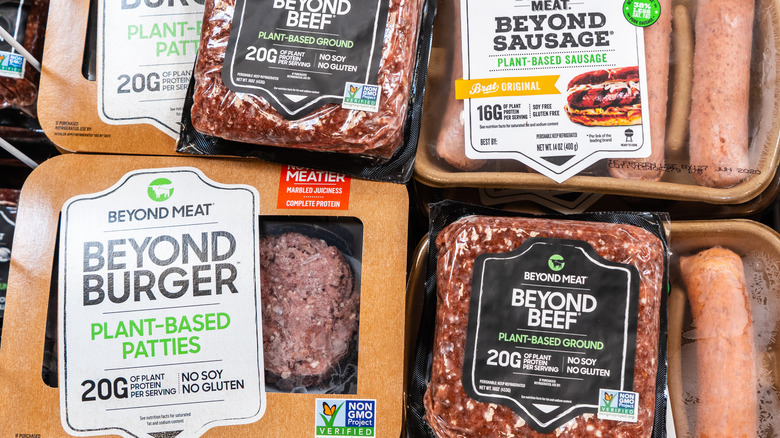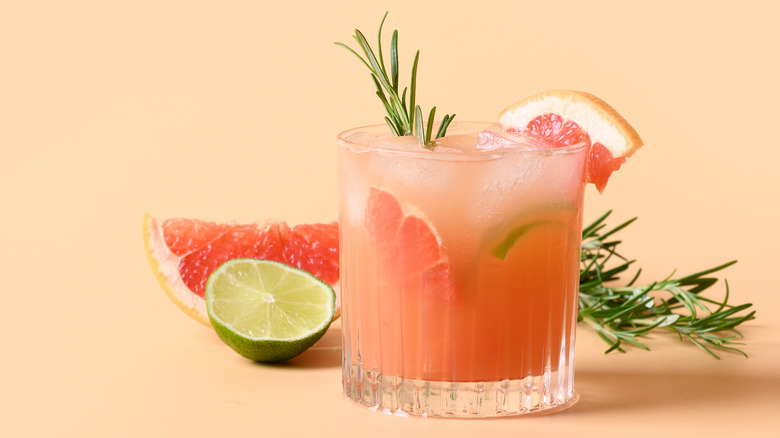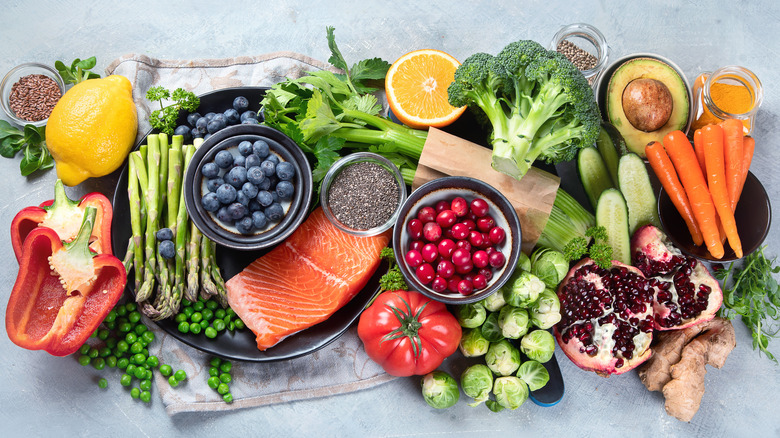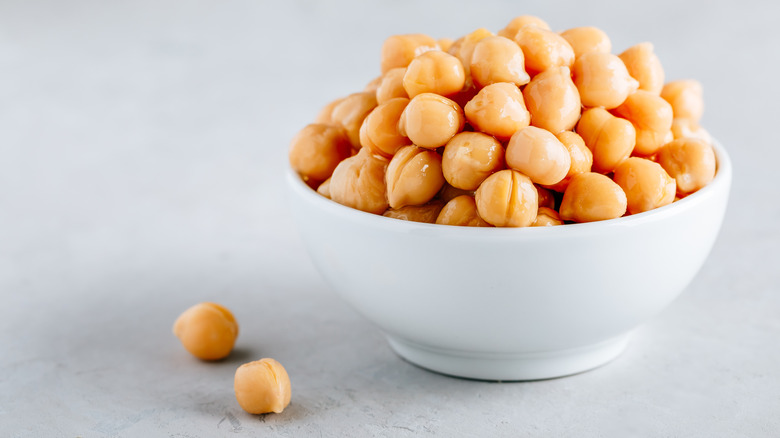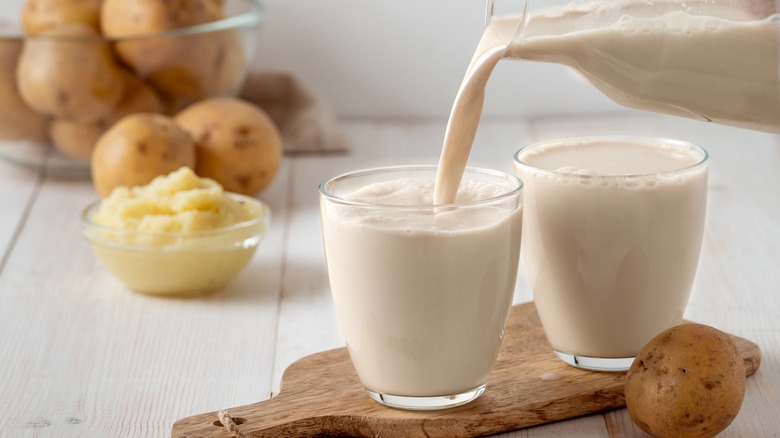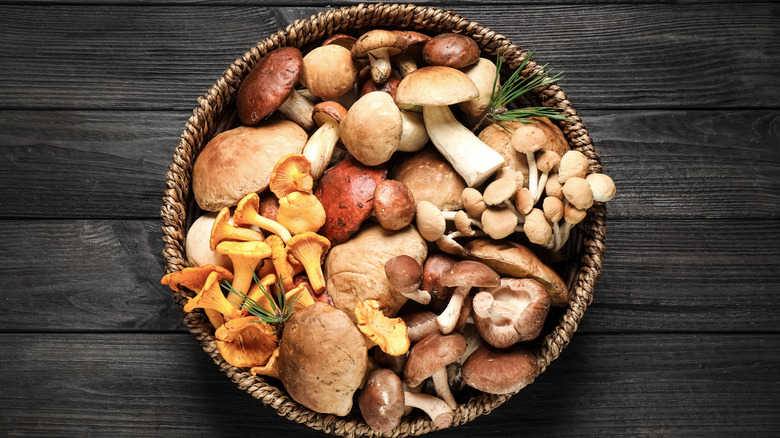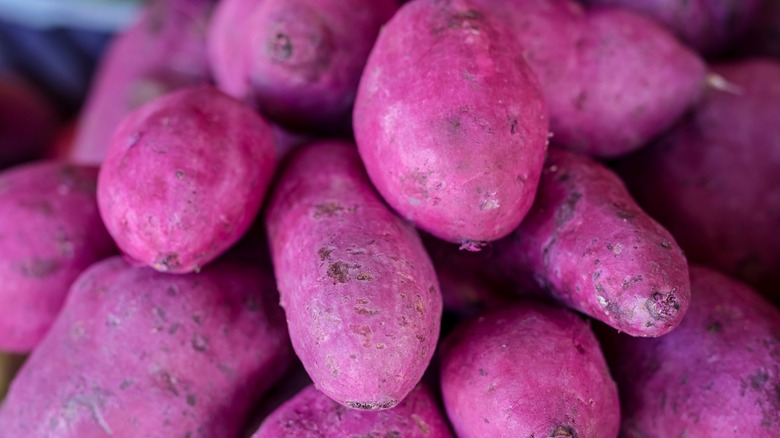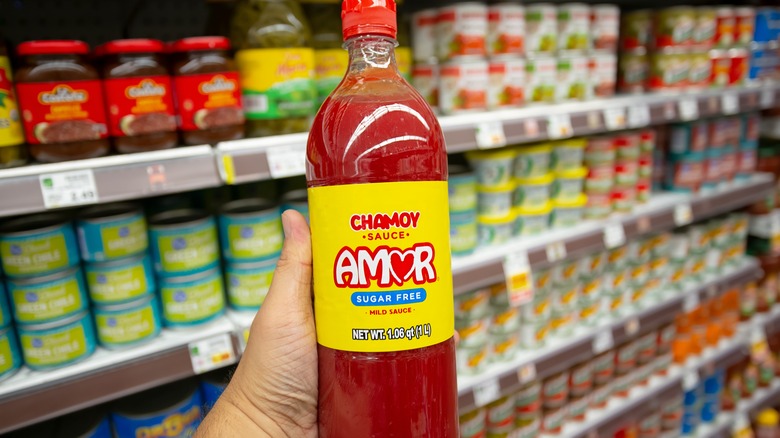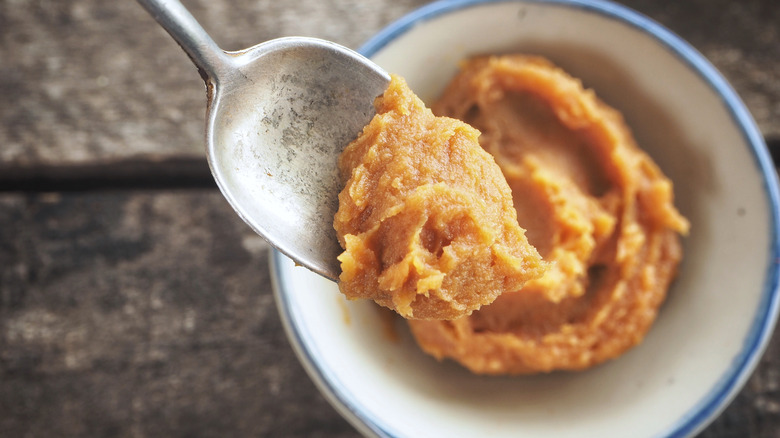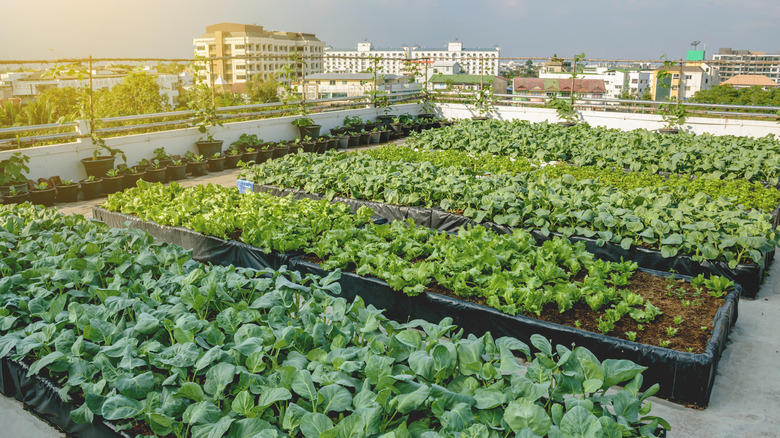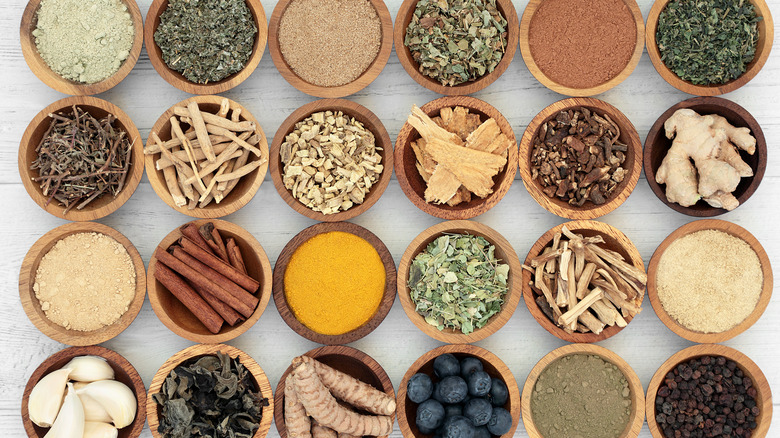Food Trends That Are About To Take Over 2023
When it comes to what's in and what's not, food and fashion are pretty much kindred spirits. Both cater to the masses and niche markets, and, at one time or another, caused quite an uproar in the world of health and wellness. When it comes to harmful food trends, take the Atkins Diet (which is different from Keto, writes Healthline), or the SlimFast shake. When it comes to fashion having a negative effect on your health, the medical specialty website Drugs.com would like to remind you about skinny jeans, high heels, and shapewear.
As you can tell, trends come and go. And it's valuable to be mindful of what ones you participate in. Whether it's being conscious of sustainability (which, spoiler alert, is an overall theme of 2023), or not breaking the bank to participate in a food trend, mindfulness is key. With that in mind, keep reading for the following forecasted food trends for 2023.
Sustainability is the overall theme
If you haven't noticed already, there's been an increase in ways to preserve the earth for future generations. In other words, it's what the EPA calls sustainability.
This isn't like a fad diet or horrible fashion trend that you wish would go away. It's more like a philosophy you should abide by if you care about the current and future welfare of the planet and the creatures that inhabit it. According to Active Sustainability, there are three pillars of sustainability that need to be addressed on a global scale: environmental, social, and economic. But getting everyone on the same page is kind of a feat in itself. Environmental sustainability entails conservation, using renewable resources, eating zero-waste foods, and being thoughtful about sustainable architecture and travel.
For example, at the time this article was published, the 2021-2022 fishing season for red king crab was canceled, as noted on Seafood Source. The reason? Dwindling biomass, or rather, too little numbers of mature females and too many mature males. This number has apparently been on a steady decline since 2019. If you purchase sustainable seafood (or meat products in general), you're helping maintain the population and also aiding in ecosystem preservation. Social sustainability means all cultures have access to good healthcare, education, and quality of life. Economic sustainability means that the above sustainable practices generate a profit for all individuals. All types of sustainability are on the rise for 2023.
Plant-based foods and seaganism
Thanks to inflation, plant-based meat sales have seen a decline over the past few months, as noted by the Food Institute. But that doesn't mean faux meat is disappearing anytime soon. While it's true that the market is saturated with a plethora of different refrigerated veggie-meat brands, what customers are showing interest in is sustainable, affordable, and flavorful plant-based seafood options. In the past, offerings were limited (and pretty darn rubbery). While companies like Gardein have been in circulation with f'shless fillets and cr'b cakes, more and more convincing faux seafood companies are catching a ride on the sustainable plant-based seafood wave (via Viable. Earth).
In addition to more seafood-friendly faux-fish options, consumers of veggie meats and plant-based products are also demanding more transparency when it comes to listing ingredients, states Supermarket Perimeter. Customers are looking for what is commonly referred to as "clean labeling," writes the Institute of Food Technologies. Unfortunately, there's not an officially designated definition for what makes a clean label a clean label. But the folks at Grande Custom Ingredients Group break it down nicely, by stating that the food items should contain minimal ingredients, that are free from additives, chemicals, or synthetic nastiness. Taking it one step further, ingredient transparency tells consumers where the ingredients came from, if they were ethically sourced (fair trade certified), the company's environmental impact, whether the vegetables involved had friends, etcetera.
Nootropic beverages
Non-alcoholic cocktails, wines, and other normally boozy beverages may sound oxymoronic, but, according to Forbes, consuming alcohol-free drinks is trending on an upward swing. Over the pandemic, society as a whole became more aware of how food and drinks truly affect your body, and abstaining from alcohol was one of those main topics.
But what are you supposed to do if you want to engage in some social drinking but don't want to possibly overindulge (or have volunteered as the designated driver)? That's where nootropics come in. When broken down, the word "noos" pertains to "mind," while "tropein" means "to monitor," reports ScienceDirect. Also called cognitive enhancers, as noted by the Alcohol and Drug Foundation, these synthetic substances are both prescription-based (like Adderall), and also available over the counter. Ginkgo, B12, 5-HTP, L-Theanine, bacopa, and even caffeine and are all considered to be nootropics and are being added to different drinkable concoctions so that you can have a nootropic brewskie without having to worry about making decisions that only alcohol has the ability to convince you to do. Plus, nootropic bevs are toted as helping improve memory as well as knock down your stress levels. Grand Market Research report that the nootropics market, in general, is expected to reach over $29 billion by 2028, with drinkable cognitive helpers leading the nootropic trend, so expect to see them chillin' next to your vitamin C supplements for a while.
Clean eating
Simply put, clean eating means that you're consuming foods that are as close to their natural state as possible, writes the Mayo Clinic. This type of eating doesn't mean you're sticking to solely a plant-based diet, but it does mean that you're coerced into a more mindful way of eating. By following a diet filled with whole-filling foods like fruits, vegetables, healthy grains, and sustainably sourced proteins, per Medical News Today, you're also seriously giving the planet a hand up.
In an article published in National Geographic, greenhouse gas emissions would drop over 50% if the entire planet adopted a vegan diet, and were we all to become vegetarian, emissions would drop by 44%. (But let's be honest, that's not really a realistic concept.) The fact of the matter is that our food system and dietary preferences directly and negatively impact our planet, and make up at least ¼ of all greenhouse gas emissions, as reported in this abstract by the Proceedings of the National Academy of Sciences. So if you're looking for a way to instantly help our planet begin to heal, look no further than preparing your own kitchen. It may seem a bit daunting, but preparing healthy, whole-ingredient meals at home can also be beneficial to your mental health, per Very Well Mind.
Chickpeas
These unassuming legumes are pretty much known for being the main ingredient in hummus (which literally translated means "chickpea"). They're also pretty neutral when it comes to flavor and color, are gluten-free, low fat, high in protein, and pretty inexpensive, writes Healthline. Their wide availability makes them a great source for individuals following a plant-based diet, or those of you looking to add a bit of variety into your foodie world. Chickpeas are also high in fiber, zinc, choline, magnesium, and folate.
On the sustainability front, chickpeas are a favored crop by farmers. This is because these little legumes excel at returning nitrogen back to the soil, which means bigger, better, healthier crops. Because these little powerhouses are so good at making soil happy, they're often used as rotational crops, writes Vegconomist. The liquid that canned chickpeas swim in is called aquafaba. This rather flavorless brine can actually be used as an egg substitute in baked goods and even whipped up for meringues. You'll never look at a can of garbanzo beans the same way again.
Potato Milk
First, there was regular dairy cow milk. Then, there was nut milk. Next, came milk made from grains, which was then followed by seed milk. It's only natural that we'd progress to potato milk, right? While some of you might be okay with not trying this starchy vegetable-based beverage, those of you ready to hop on the potato milk express will have to wait. According to Business Insider, this product is only available in China, the U.K., and Sweden, and is unfortunately not available in the United States... yet. Being the creative beings that we are, it's not too difficult to find copycat recipes for potato milk, like this particular version from Today. So if you're into experimenting, go forth and, uh, milk it?
But why potatoes? It actually makes a lot of sense, especially in terms of sustainability. DUG (the company responsible for potato milk) states that potatoes truly are a humble and fuss-free crop. Not only can they grow almost anywhere, but it's also space smart (when compared to other crops like oats or rice). When it comes to water, the independent research blog HEALabel reports that it takes 34 gallons of water to produce a pound of potatoes and 451 gallons to produce 1 pound of soy milk. In comparison, 1 pound of shelled almonds uses 1,929 gallons of water.
Mushrooms
It's time to stop turning your nose up at these fantastic fungi because, frankly, they're pretty magical. (But not in the way you're thinking.) Sure, some of them taste like dirt, but once you cook them with other flavorful herbs and spices, the humble fungus will be transformed. According to Mushroom Appreciation, there are over 10,000 different varietals that we know about, and many more that we don't. They're classified into four subtypes, which dictate how they feed: saprotrophs, mycorrhizae, parasites, and endophytes. Saprotrophs live off of decaying matter and help break things down. Morels, buttons, shiitake, and cremini are a few that fall under this category. Mycorrhizae — truffles, porcini, and chanterelles — like to hang out with other plants and trees and help them grow bigger and stronger, while their foliage friend feeds them sugars and nutrients. Parasites are what the name suggests. They prefer a one-sided relationship, which isn't very nice, but they still taste delicious. (We're looking at you, Lion's Mane.) Endophytes are somewhat alien fungi that share classifications.
Mushrooms are being used in everything from textiles to food to packaging and even water capturing, says Engineering & Technology. They're also being utilized as the main ingredient for much plant-based seafood. HEALabel notes that mushrooms have almost no carbon footprint, and Lacademie writes that they could even be beneficial for treating depression.
Unfamiliar flavors
2023 is going to be the year of complex, layered, and unfamiliar flavors, writes Strategy Online. At least, flavors that are unfamiliar to most people living in the United States. You might've been seeing a lot of vibrant purple desserts or heard of baked goods made from something called ube, and it's a yam native to the Philippines. According to Kapwa Gardens, this purple yam has been part of the Filipino foodie culture for over 400 years. Ube is a vitamin-packed tuber and is high in vitamins A, C, and E. It's also a great source of potassium and fiber, and could also carry anti-cancer fighting properties, as noted in this 2019 abstract on the benefits of eating colored vegetables.
Yuzu is another flavor that you might have seen gracing the shelves at your local Whole Foods or Trader Joe's. Yuzu is a small citrus fruit that looks like a mandarin orange but tastes a bit like a grapefruit. This Japanese citrus fruit is high in vitamin C, but unlike limes or lemons, it doesn't contain much juice... and the seeds are pretty big, notes Everyday Health. It works well with sparkling water or in mocktails and cocktails.
If you've had the pleasure of eating lychee, you'll never forget the taste or texture. Though 2020 wasn't the best year for lychee farmers, according to Mordor Intelligence, this floral-tasting fruit is seeing demand across Europe.
Butter boards
Have you heard of a butter board? It's like a charcuterie board, but not really.
A butter board has three basic needs: a wooden serving or cutting board, a dizzying amount of butter, and something to dip into it. Crostini, pita, and breadsticks are all options. Once you've acquired these three items, the remaining ingredients are up to you. You can leave your butter board simple by adding a bit of flaky sea salt, fresh cracked pepper, and lemon zest. Or go the polar opposite way and get complex, like this Tandoori butter board by Naturally Nidhi.
According to The New York Times, the butter board trend originated on TikTok and quickly escalated from showcasing an otherwise overlooked ingredient, to other individuals taking the idea and running with it. Moreover, Forbes reports that there are a few health hazards associated with this trend-tastic tasting board. If the board you're using hasn't been sealed or has any cracks, you're tempting bacteria to make themselves at home, create a family, and invite food poisoning into your life. If you're hosting a party and have one of these on display, you'll have to watch out for double dippers and flying foes (like bugs or pet fur). Plus, that's just really a lot of butter to eat.
Swicy foods
Human beings love simple flavors that complement one another. We also rather enjoy creating our own linguistics, which, if trendy enough, can ultimately end up being added to Merriam-Webster's lexicon. (For example, the words TBH, fluffernutter, and amirite were new dictionary additions in 2022, as noted by People First Content.) At the time this article was written, the adjective "swicy" — a combination of sweet and spicy — has not yet been added to the global glossary.
Swicy foods have seen a surge of interest over the past few years, and just like the slow and lingering burn of a ghost chili, that captivation isn't showing any sign of letting up, according to the spice maestros at McCormick Flavor Solutions. In particular, spice blends like chaat masala (which includes cumin, dried green mango powder, dried pomegranate seeds, black salt, red chili powder, black peppercorns, and cane sugar, via Tea for Tumeric) and mangonada are being fanned by the flames of trending flavors. Mangonada, notes Trend Hunter, is almost like a Mexican sorbet and incorporates blended mango (fresh or frozen), chili lime salt (called Tajín), chamoy sauce, lime juice, and sugar.
Fermented foods and umami
Fermented foods have long been sought after for their probiotic and overall health benefits, and are seeing another upswing in popularity, according to SpoonShot. But although these funkalicious foods have already seen a rise and fall in interest over the past decade (give or take), this time around, they're not necessarily showing up in their true form, and they're also arriving with a compatible flavor partner. Remember that swicy flavors were projected to be big in 2023? Another trending taste will purportedly be a fusion of sweet combined with funky fermentation flavors (umami).
When we talk about fermented foods, you might automatically think of sauerkraut or some sort of pickled vegetable. But foods like miso are projected to hit it big in 2023. McCormick Flavor Solutions has released a line of blended seasonings that combine rich, sweet, and decadent with the salty, umami-forward miso. A 2018 release by The Fermentation Association projected that fermented foods and flavors were expected to rise (like a sourdough starter) from over $635 billion to upwards of $888 billion by 2023. These sometimes beneficial foods are also incredibly sustainable, writes Yogurt in Nutrition, because creating these sometimes odoriferous foods reduces food waste and brings nutrient-rich foods to communities that are strapped for resources and financially burdened.
Hyper local food
Perhaps you've heard of the word "locavore." This term was first grown back in 2005 and was essentially a challenge to see if San Franciscans could only eat foods that were sourced within 100 miles of their city, as noted on Holiable. A locavore engages in seasonal eating and prefers to eat ingredients that have been grown within their city or county limits. This also keeps money circulating back into the local economy and reduces carbon emissions from long-distance food travel.
Hyper-local food is grown or cultivated incredibly close to where it's being consumed, according to Eco & Beyond. By "incredibly close," we're talking inside the city limits, per Conde Nast Traveler. The locations where the fruits, veggies, and herbs are grown, however, aren't your typical plots of land. You can expect to find these ingredients hydroponically grown in basements, vertically grown on the sides of walls, or even flourishing on top of multi-level skyscrapers or hotels. Generally, the amount of produce that's grown is only enough to sustain a few restaurants, which means hyper-local produce is incredibly small scale. Small scale also means produce is easier to oversee, which means there's no need for pesticides or preservatives. Food Truck Operator also says that hyper-local growing eliminates any use of fossil fuels because your food isn't arriving courtesy of a diesel-guzzling semi-truck. That also means less unnecessary spoilage, which means less greenhouse gas production from rotting food waste in landfills.
Functional food and drink
The ancient Greeks knew a thing or two about eating and drinking (and we're not just talking about, what the Historical Index calls, a Dionysian Bacchanalia). You might've heard of Hippocrates, otherwise known as the father of modern medicine, per Britannica. This is the guy who supposedly coined "let thy food be thy medicine and thy medicine be thy food," or something like that, adds Science Direct. Well, Hippocrates lived over 2,400 years ago, so you'd think that we would've taken his advice by now. Instead, we're over there mowing down on processed lunch meats, deep-fried Twinkies, and, well, you get the idea.
But at least we in the U.S. are finally beginning to understand that food is medicine, right? (It only took a modern-day pandemic to really hit it this concept home.) While we live in a culture that's rather obsessed with all sorts of wacky diets, you can expect that 2023 will be the major turning point for using foods to help heal the body and improve overall health and wellness. Throughout the COVID-19 pandemic, there was, and continues to be, a surge of interest in functional foods, which Healthline defines as foods that not only feed you but also heal you. This trend doesn't show any signs of slowing down. So also be on the lookout for food and beverages that are infused with adaptogens, like ashwagandha, and even CBD, writes Flavor Sum.


